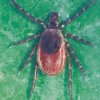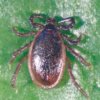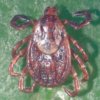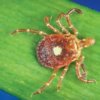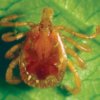Lyme disease is the most common tick-related disease.
- In 2002, 23,763 cases were reported. 95% of these cases came from 12 states, most commonly Connecticut and Rhode Island
- Lyme disease is often under-reported. Reported cases typically comprise only 10-20% of all actual cases
- In 2014, 33,461 cases were reported
Symptoms
- Erthema migrans (EM), a red rash, typically appears 2-32 days after a tick has detached – it is not painful but may feel warm to the touch
- The rash will expand over time to about 6 inches
- It may be uniformly red, have a clear center, or, occasionally, a bull’s eye appearance
- It will disappear without treatment
- Other symptoms include: fever, headache, chills, fatigue, and joint and muscle pain
Steps to Prevent Lyme Disease
- Check for ticks daily, especially in spring and early summer. The tick must be attached for 24 hours for Lyme disease to be transmitted
- Remove ticks with tweezers by grasping the mouth parts and pulling in a slow, steady manner


